Fort Qu’Appelle, Saskatchewan 作者: 来源: 发布时间:2021-12-02
I.Population and Area
-Area:
•Total: 5.28 km2 (2.04 sq mi)
-Population (2006)
•Total: 1,919
•Density: 363.2/km2 (941/sq mi)
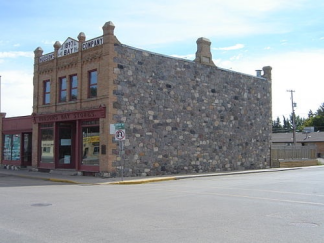
II.Natural Geography (environment and resources)
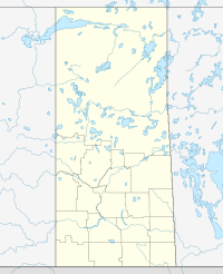
-Fort Qu'Appelle is a town in Southern Saskatchewan, Canada located in the Qu'Appelle Valley 70 km NE of Regina between Echo and Mission Lakes and not to be confused with the once-significant nearby town of Qu'Appelle. It was originally established in 1864 as a Hudson's Bay Company trading post. Fort Qu'Appelle, with its 1,919 residents in 2006, is at the junction of Sk Hwy 35, Sk Hwy 10, Sk Hwy 22, Sk Hwy 22, Sk Hwy 35, Sk Hwy 56, and Sk Hwy 215. The 1897 Hudson's Bay Company store, 1911 Grand Trunk Pacific Railway station, Fort Qu’Appelle Sanatorium (Fort San), and the Treaty 4 Governance Centre in the shape of a teepee are all landmarks of this community. Additionally, the Noel Pinay sculpture of a man praying commemorates a burial ground, is a life sized statue in a park beside Segwun Avenue.
III.ECONOMY
-Total - Income statistics in 2015 for economic families in private households - 100% data: 525

-Website: https://www12.statcan.gc.ca/census-recensement/2016/dp-pd/prof/details/page.cfm?Lang=E&Geo1=POPC&Code1=0294&Geo2=PR&Code2=47&SearchText=Fort%20Qu%27Appelle&SearchType=Begins&SearchPR=01&B1=All&GeoLevel=PR&GeoCode=0294&TABID=1&type=0
IV.Industrial Characteristics
-The town's substantial growth beyond its status as a Hudson's Bay Company "factory" first occurred in the 1880s and 1890s when European settlement began in the region as the Canadian Pacific Railway moved westwards: a post office opened in 1880. This coincided with the first development of British India after the seizing of control of India from the East India Company by the Crown after the 1857 Indian Mutiny, and the town of Fort Qu'Appelle's striking similarity to the Indian hill stations of the early Raj has been widely commented upon by anyone who has seen both. Although the North-West Mounted Police headquarters was established in Regina once it was named capital of the North-West Territories in 1882, the substantial police station at the western end of the town of Fort Qu'Appelle remained significant as centre of service within the valley and in rural communities and to farms in the plains region: this became more important though less as nearby towns declined from the beginning of the Great Depression in 1929 and continuing after World War II.
-Older residences and commercial premises together with the town's Anglican and United (formerly Presbyterian) churches are quintessentially of the 19th century hinterland British Empire, a matter which local civic boosters and cultivators of tourism appear not yet to have capitalised upon. "In 1913, construction began on a fish culture station near Fort Qu’Appelle and, to date, the facility has supplied more than 2 billion fish to stock water bodies throughout the province....[T]he Fort Qu’Appelle Sanatorium (Fort San) for tuberculosis patients...[opened in] 1917."
-The ample commercial shops were substantially busier than merely for town residents, being grocery and supply centres for the ample number of farms; the Fort Hotel of the early 20th century through the 1960s had a well-attended pub with its parking lot full late Friday afternoons through evenings. A large drive-in movie theatre stood on Bay Avenue south of the railway track just before the entry into the coulee on Highway 36 to leave the valley; it had lively attendance by townspeople, cottagers and farmers until the 1960s when home television significantly improved and the drive-in closed.
-Despite the accelerating decline of rural Saskatchewanian population in the post-World War II years as farms needed to be larger and therefore fewer in number for economic viability, the town grew through most of the 1950s and 1960s as a cottage community serving the Qu'Appelle Lakes summer-cottage country in the valley up- and down-river from the town. Cottagers from Regina and other southern Saskatchewan communities used Fort Qu'Appelle as a base from which to explore the scenic and historic river valley, purchase hardware and groceries and contract services; the town also benefited urban drift as farms and other towns steadily depopulated.
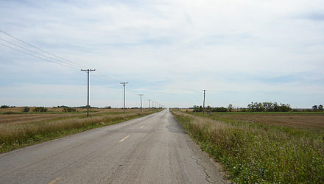
Highway 35 between Qu'Appelle and Fort Qu'Appelle
-This process was precipitately accelerated in the early 1960s. Highway 35 had reached Fort Qu'Appelle by branching off the Trans-Canada Highway at the once-significant town Qu'Appelle and somewhat laboriously proceeding into the Qu'Appelle Valley by winding through an un-occupied coulee. The old highway was supplemented and effectively replaced by Highway 10, leaving the Trans-Canada at Balgonie and taking a straight route from the plain into the valley. This vastly eased access from the southwest and increased Fort Qu'Appelle's attraction over other market-places for farmers.
-19th-century country school building elsewhere shown while still in use; here photographed in 1970, seven years after closure of successor across the road, from site of teacher's residence: demonstrating steady depopulation of farm neighbourhoods.
-In 1963, with steadily decreasing density of farm neighbourhood populations and increasing quality of highways, the rural school districts were abolished and farm primary and high school children—taught in one building with one or two classrooms—were thereafter bused to town schools. Rural churches having largely closed in the 1950s, the collapse of rural farming communities was now assured, to the benefit of minor metro-poles such as Fort Qu'Appelle though arguably to the impoverishment of the community as a whole. With the building of Highway 10 making access to Fort Qu'Appelle from outside the valley easier and faster, the process of farmers using it rather than previously substantial towns such as Qu'Appelle, Edgeley and Balcarres for selling grain and buying groceries further increased its size and vitality. The town itself is today "a shopping, service, and institutional centre serving the surrounding [f]arming community, neighbouring resort villages, cottagers and summer vacationers." Many traditional lake summer cottages have become year-round residences, together with winter skiing further expanding demand for the town's shopping facilities.
-Business Infrastructure
-The Town of Fort Qu’Appelle recognizes the importance of planning for the future to ensure continued community economic development is stimulated. The policies within this Plan provide guidelines to reduce conflicts between land uses, protect sensitive environmental areas, build relationships and collaborate with neighbouring municipalities and First Nations communities, and to develop strategies which support community revitalization and population growth. The policies in this Plan are enabling and several key initiatives, as outlined in the Action Plan Section, are recommended to develop progress and results reflective of the comprehensive land use plan for the Town.
-Website fo the future community plan: http://www.fortquappelle.com/public/Files/OfficialCommunityPlan.pdf
V.Attractions
1.Motherwell Homestead National Historic Site
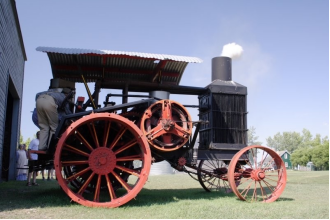
-Road trip with your family out to Abernethy and visit the Motherwell Homestead National Historic Site to meet farm animals and discover prairie life in the 1900s. Have a blast while exploring the home and farm of W.R. Motherwell and discover his influence on the development of agriculture in western Canada. Join staff at work in the fields, caring for the many farm animals or working in the old stone house. Enjoy a wagon ride and smell the fresh-cut hay. Indulge in the freshly made flavours at the Off The Beaten Path Café and take a stroll along the wetland trail. Step out of the hustle and come back to the farm. Don't miss the live farm animals, Xplorers for kids, the Explora Tour App, discovery booklets, many fun photo opportunities and Children's Day Camps in July and August (by reservation only). Visitor Centre, century-old fieldstone house, barn and interpretive signage. Visit website for 2019 Special Events schedule. Follow Motherwell on Twitter at #MotherwellNHS.
-Phone(s): 306-333-2116 | 866-787-6221 (TTY) | 1-888-773-8888 |
pc.lhnhomestead-motherwell-motherwellhomesteadnhs.pc@canada.ca
-Open May long weekend to Labour Day. May 20 to Jun 28, Mon to Fri 10 a.m. - 4 p.m.; Jun 29 to Sep 2 daily 10 a.m. - 4 p.m.
-3 km S of Abernethy off Hwy 22. GPS: 50.4346N, -103.2527W.
-Latitude: 50.73909° N, Longitude: -103.4239° W
2.Mission Ridge Winter Park
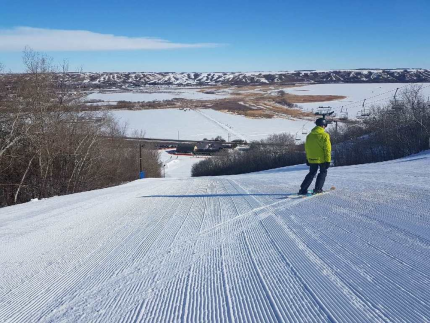
-Located in the scenic town of Fort Qu'Appelle, Mission Ridge Winter Park is southern Saskatchewan’s premier skiing, snowboarding and tubing facility. Mission Ridge features 14 marked runs, the longest measuring over 800 metres, two terrain parks, three conveyor lifts, a triple chair lift and a brand new lift-serviced Tubing Park. The park also offers high quality ski/snowboard rentals, professional instruction with nationally certified instructors and is fully wheelchair accessible to accommodate skiers, snowboarders and guests of all abilities.
-Mission Ridge Winter Park’s extensive snowmaking system blankets all 14 runs and the Tubing Park in just under one metre of snow pack each season and the team ensures conditions are always pristine and groomed fresh every morning.
-Don’t forget to visit Bubba’s at Mission – a full menu, fully licenced restaurant located in the main Daylodge at Mission Ridge Winter Park. Enjoy juicy burgers, famous Bubba’s Pizza, an overstuffed calzone or savoury steak sub while warming up in the Red T-Bar Lounge by the wood burning fireplace.
-Phone(s): 306-332-5479 | 1-800-550-6857 (Snow conditions) |
daylodge@missionridge.ca
-Open Dec 1 to Mar 30.
-Within town limits, 1 km SE of downtown Fort Qu'Appelle.
-Latitude: 50.75643° N, Longitude: -103.7823°
3.Fort Qu'Appelle Museum
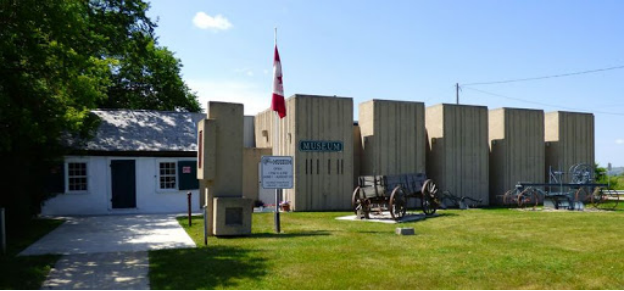
-On the site of the original 1865 Hudson's Bay Company trading post, the Fort Qu'Appelle Museum displays Indigenous, Hudson's Bay Company, North West Mounted Police (NWMP) and Fort San artifacts plus a variety of antique photos, tools and items.
-Phone(s): 306-332-6033 | 306-332-4503
-Open Jun 1 to Aug 31.
-Daily 1 - 5 p.m.; remainder of year by appointment.
-Bay Ave and 3rd St, Fort Qu'Appelle.
-Latitude: 50.77154° N, Longitude: -103.7982° W
VI.History
-The current site is the third Fort Qu'Appelle. The first was a North West Company trading post (1801–05), also in the valley but near what is now the Saskatchewan-Manitoba border. The Hudson's Bay Company itself first used the name for a post north of present-day Whitewood (some 174 kilometres east of Regina on Number 1 Highway) from 1813 to 1819.
-Prior to the mid-19th century establishment of the more lengthily surviving fur-trading post at the ultimate site of the town, it "was the hub of several historic trails that traversed the northwest". It was the site of a Hudson's Bay Company post from 1852 to 1854. An Anglican mission was established, which still survives as the town's St. John the Evangelist Anglican parish church.
-The post was revived again from 1864 to 1911. With the signing of Treaty 4 by Cree and Salteaux aboriginal peoples at Fort Qu'Appelle the North-West Mounted Police, now the RCMP, arrived and have maintained a continuous presence in the town ever since.
-Substantial transformation of Fort Qu'Appelle occurred when farm development began in the 1880s and farmers required a nearby urban centre for selling their grain and other products, purchasing agricultural and domestic supplies and for social gathering beyond rural schools and churches. It was not anticipated that initial partition of agricultural land into farms of one-quarter section (250 acres) would not last long and farm population would substantially reduce very quickly; the process accelerated in the 1970s when farmers began selling their land and retiring in substantial numbers to Fort Qu'Appelle and the custom of elderly farmers remaining at home with offspring past into history, with more retiring to town.
-The name "Qu'Appelle" comes from "is French for 'who calls' and is derived from its Cree name, kah-tep-was ('river that calls'). There are several versions of the origin of this name, but the most popular suggests it refers to a Cree legend of two ill-fated lovers." The name refers to the once-popular legend of the Qu'Appelle Valley versified by Pauline Johnson and known nation-wide. "Fort Qu'Appelle was the crossroads of a number of historic trails that traversed the North-West Territories.”
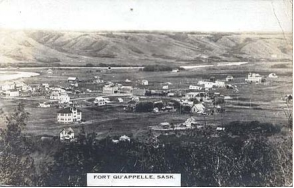
Fort Qu'Appelle, circa 1910.
-The town is immediately adjacent to the site of the original Fort Qu'Appelle Hudson's Bay Company trading post, whose "factory" is maintained as a historical site and museum. The Hudson's Bay trading post was built in 1864 when the Company's activity was still largely confined to the fur trade with indigenous residents. "[P]emmican was shipped down valley on a Hudson's Bay Company cart trail to supply the paddlers of the fur trade in more forested regions."
-Despite the once well-known gathering of General Middleton and soldiers at Qu'Appelle, at the western-most extreme of the still-incomplete Canadian Pacific Railway and some kilometres south of the Qu'Appelle Valley, "[i] Middleton empowered Captain French, an Irish officer who had been in the North-West Mounted Police (NWMP), to raise a mounted force in the vicinity of Fort Qu’Appelle. ... This mounted troop ... joined the 10th Royal Grenadiers from Toronto and the Winnipeg Field Battery under the command of artillery officer Lieutenant-Colonel C.E. Montizambert, to form the west-bank column that would march from Qu’Appelle to Batoche", where the notorious battling would occur.
-After ethnic European settlement by farmers had become established in the 1880s—a post office being established in 1880—the original Hudson's Bay Company activity was replaced by its department store on Broadway Street in 1897. By this time the fur trade had lapsed but the town community and farmers travelling into town for shopping had substantially increased in number. The store building remains though long disused by the Bay.
-There was once certain ambiguity as to entitlement to the town-name between the present town and the once-significant regional centre bearing the name "Qu'Appelle"; the matter ceased to be an issue in 1911 when the two communities agreed to deem the then-CPR station site as Qu'Appelle and the town in the valley as Fort Qu'Appelle.[20] As did the town of Qu'Appelle, Fort Qu'Appelle early-on had "a bid to succeed Battleford as the territorial capital" but "lost out to Regina ... in 1882".
-The name Fort Qu'Appelle was given to a number of trading posts in the Qu'Appelle valley. Near Fort Espérance both the Hudson's Bay Company and the North West Company had temporary posts that were apparently called Fort Qu'Appelle. (The Hudson's Bay Company and the North West Company merged in 1821.) From 1855 until 1864 the Hudson's Bay Company had a Fort Qu'Appelle a little south of McLean, Saskatchewan. It was an outpost of Fort Ellice and was mainly a source of pemmican. In 1864 it was moved to the present site of Fort Qu'Appelle.
-Police parade before Hudson's Bay Company shop, built before the town developed
-Three industrial boarding schools for First Nations adolescents were established in 1883, including one on the south side of Mission Lake across from Lebret on the north side of the lake, as well as Battleford and High River.
-It was often claimed that colonial administration of Canada, once "British North America", was very different from that in other British colonies. But it has been alleged to have been corruption on the part of Edgar Dewdney when he was Lieutenant-Governor of the North-West Territories to place the capital in Buffalo Bones rather than Fort Qu'Appelle or Qu'Appelle. On the other hand, Fort Qu'Appelle is strikingly similar to Murree, northeast of Rawalpindi and once the summer capital of British India, and Maymyo, Burma highlands. It was in 1915 that "Sir Robert Borden has been invited by the Saskatchewan Art Society to unveil a memorial at Ft. Qu'Appelle to the signing of the first treaty in 1874 between the Dominion and the plains Indians." The site of the fort was designated a National Historic Site of Canada in 1953.
VII.Other information
-Fort Qu'Appelle and nearby Qu'Appelle Valley sites have almost from the beginning of township provided ample recreational sites and are a notable tourist destination both in summer and winter. "[I]in the years prior to World War I ...the recreational potential of the district began to be exploited and numerous cottages began to appear on the area lakes." The lakes afford swimming, boating and other water related activities in summer and cross-country skiing, snowmobiling and ice fishing in winter. There is also Echo Valley Provincial Park located between Echo Lake and Pasqua Lake. The park provides an RV park, camping, swimming, boating and fishing.
-"To the visitor, southern Saskatchewan Qu'Appelle Valley might, at first glance, appear to be a mirage. Bordered by seemingly-endless farmland flatness, the dramatic physical features of the valley appear somewhat out of place.
-The long-closed railway station was originally of the Grand Trunk Pacific Railway, "incorporated in 1903 as a subsidiary of the Grand Trunk Railway" and "[b]y 1923, [with] the Grand Trunk Railway, and the National Transcontinental merged with the Canadian Northern Railway to form the new Canadian National Railway.” "[M]any prairie branch lines closed after 1945; the passenger service was terminated in 1978.” immediately to the west of Fort Qu'Appelle, approximately halfway along the south shore of the lake; a popular holiday resort and commuter community since the 1880s. The Grand Trunk Pacific Railway station nonetheless continues to stand, maintained as a site for current information on attractions and activities. After closure as a medical facility, Fort San was used as a summer musical facility until the 1990s with choir concerts in the nearby Sacred Heart Roman Catholic Church in Lebret.
-The most notable tourist event is Treaty 4 Gathering, is a week-long event celebrating the signing of Treaty #4. The event is held in September, during the week of the 15th. Pow-wows are held daily during the week. See below as to past participation in such events by the perhaps most world-famous person of local origin, 1960s folksinger and activist Buffy Sainte-Marie.
-Aforementioned winter downhill ski-ing, currently at the Mission Ridge Ski Hill, attracts ski-ers not only from the town but elsewhere in the region including the city of Regina.
VIII.Contact information
-Government
•Governing body: Fort Qu'Appelle Town Council
•Mayor: Jerry Whiting
•Administrator: Larry Davidson
-Address:
136 Boundary Ave. South
P.O. Box 309, Fort Qu'Appelle, SK S0G 1S0
-Hours:
Monday-Friday
8:00am - 4:00pm
-Phone: (306) 332-5266
-Fax: (306) 332-5087
-Email: forttownoffice@sasktel.net or forttown@sasktel.net
-Website: http://www.fortquappelle.com/contact
